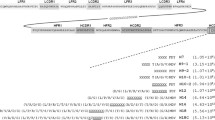Abstract
Human Supervillin isoform 4 (SV4), a bigger splicing isoform of Supervillin, contains extra coding exons 3, 4 and 5 (E345), compared to Supervillin isoform 1. Although previous studies have shown that SV4 associated with membrane and cytoskeleton, regulated cell migration and cell survival, its functions are still largely unknown. To broaden our understanding, SV4 specific antibody is important for further study in signaling pathway. The His-SV4 (E345) and GST-SV4 (E345) fusion proteins, which contained SV4 specific domain E345, were purified from bacteria. The His-SV4 (E345) proteins were injected in rabbits as immunogen to produce anti-SV4 serum, and SV4 antibodies were purified by GST-SV4 (E345) proteins cross-linked to affinity resins. SV4 antibodies exclusively recognized SV4 protein both in vitro and in vivo through multi-step testing by ELISA, western blot, immunoprecipitation, and immunofluorescence. Taken together, our data demonstrate a novel SV4-specific polyclonal antibody which will provide a useful tool for further characterization of SV4 function.





Similar content being viewed by others
Abbreviations
- SV:
-
Supervillin
- SV1:
-
Supervillin isoform 1
- SV2:
-
Supervillin isoform 2
- SV4:
-
Supervillin isoform 4
- E345:
-
Exons 3, 4 and 5
- SV4 (E345):
-
Supervillin isoform 4 specific domain of exons 3, 4 and 5
- ELISA:
-
Enzyme linked immunosorbent assay
References
Pestonjamasp KN, Pope RK, Wulfkuhle JD, Luna EJ (1997) Supervillin (p205): a novel membrane-associated, F-actin-binding protein in the villin/gelsolin superfamily. J Cell Biol 139:1255–1269
Pope RK, Pestonjamasp KN, Smith KP, Wulfkuhle JD, Strassel CP, Lawrence JB, Luna EJ (1998) Cloning, characterization, and chromosomal localization of human superillin (SVIL). Genomics 52:342–351
Ghoshdastider U, Popp D, Burtnick LD, Robinson RC (2013) The expanding superfamily of gelsolin homology domain proteins. Cytoskeleton (Hoboken) 70:775–795
Takizawa N, Ikebe R, Ikebe M, Luna EJ (2007) Supervillin slows cell spreading by facilitating myosin II activation at the cell periphery. J Cell Sci 120:3792–3803
Fedechkin SO, Brockerman J, Luna EJ, Lobanov MY, Galzitskaya OV, Smirnov SL (2013) An N-terminal, 830 residues intrinsically disordered region of the cytoskeleton-regulatory protein supervillin contains Myosin II- and F-actin-binding sites. J Biomol Struct Dyn 31:1150–1159
Hasegawa H, Hyodo T, Asano E, Ito S, Maeda M, Kuribayashi H, Natsume A et al (2013) The role of PLK1-phosphorylated SVIL in myosin II activation and cytokinetic furrowing. J Cell Sci 126:3627–3637
Takizawa N, Smith TC, Nebl T, Crowley JL, Palmieri SJ, Lifshitz LM, Ehrhardt AG et al (2006) Supervillin modulation of focal adhesions involving TRIP6/ZRP-1. J Cell Biol 174:447–458
Fang Z, Takizawa N, Wilson KA, Smith TC, Delprato A, Davidson MW, Lambright DG et al (2010) The membrane-associated protein, supervillin, accelerates F-actin-dependent rapid integrin recycling and cell motility. Traffic 11:782–799
Bhuwania R, Cornfine S, Fang Z, Kruger M, Luna EJ, Linder S (2012) Supervillin couples myosin-dependent contractility to podosomes and enables their turnover. J Cell Sci 125:2300–2314
Ting HJ, Yeh S, Nishimura K, Chang C (2002) Supervillin associates with androgen receptor and modulates its transcriptional activity. Proc Natl Acad Sci USA 99:661–666
Ting HJ, Hu YC, Chang C (2004) Actin monomer enhances supervillin-modulated androgen receptor transactivation. Biochem Biophys Res Commun 319:393–396
Wulfkuhle JD, Donina IE, Stark NH, Pope RK, Pestonjamasp KN, Niswonger ML, Luna EJ (1999) Domain analysis of supervillin, an F-actin bundling plasma membrane protein with functional nuclear localization signals. J Cell Sci 112(Pt 13):2125–2136
Oh SW, Pope RK, Smith KP, Crowley JL, Nebl T, Lawrence JB, Luna EJ (2003) Archvillin, a muscle-specific isoform of supervillin, is an early expressed component of the costameric membrane skeleton. J Cell Sci 116:2261–2275
Spinazzola JM, Smith TC, Liu M, Luna EJ, Barton ER (2015) Gamma-sarcoglycan is required for the response of archvillin to mechanical stimulation in skeletal muscle. Hum Mol Genet 24:2470–2481
Gangopadhyay SS, Takizawa N, Gallant C, Barber AL, Je HD, Smith TC, Luna EJ et al (2004) Smooth muscle archvillin: a novel regulator of signaling and contractility in vascular smooth muscle. J Cell Sci 117:5043–5057
Gangopadhyay SS, Kengni E, Appel S, Gallant C, Kim HR, Leavis P, DeGnore J et al (2009) Smooth muscle archvillin is an ERK scaffolding protein. J Biol Chem 284:17607–17615
Li Y, Reznichenko M, Tribe RM, Hess PE, Taggart M, Kim H, DeGnore JP et al (2009) Stretch activates human myometrium via ERK, caldesmon and focal adhesion signaling. PLoS One 4:e7489
Fang Z, Luna EJ (2013) Supervillin-mediated suppression of p53 protein enhances cell survival. J Biol Chem 288:7918–7929
Son K, Smith TC, Luna EJ (2015) Supervillin binds the Rac/Rho-GEF Trio and increases Trio-mediated Rac1 activation. Cytoskeleton (Hoboken) 72:47–64
Woestenenk EA, Hammarstrom M, van den Berg S, Hard T, Berglund H (2004) His tag effect on solubility of human proteins produced in Escherichia coli: a comparison between four expression vectors. J Struct Funct Genom 5:217–229
Zhang Y, Wu S, Wang J, Wernike K, Lv J, Feng C, Zhang J et al (2013) Expression and purification of the nucleocapsid protein of Schmallenberg virus, and preparation and characterization of a monoclonal antibody against this protein. Protein Expr Purif 92:1–8
Acknowledgments
We thank the members for technical assistance in Center of Medical Physics and Technology, Hefei Institutes of Physical Science, Chinese Academy of Sciences. This research was partly supported by the National Natural Science Foundation of China (Nos. 31571433 and 31501171), Anhui Provincial Natural Science Foundation (Nos. 1508085SMC214 and 1608085MH180) and Visiting Professorships Foundation of Hefei Institutes of Physical Science (No. Y3BZOH3058).
Author information
Authors and Affiliations
Corresponding author
Ethics declarations
Conflict of interest
The authors of this paper declare that they do not have any conflict of interest. And the SV4 antibodies were used for academic research but not for commercial field.
Rights and permissions
About this article
Cite this article
Chen, X., Li, H., Wang, H. et al. Preparation and Affinity-Purification of Supervillin Isoform 4 (SV4) Specific Polyclonal Antibodies. Protein J 35, 107–114 (2016). https://doi.org/10.1007/s10930-016-9658-x
Published:
Issue Date:
DOI: https://doi.org/10.1007/s10930-016-9658-x




